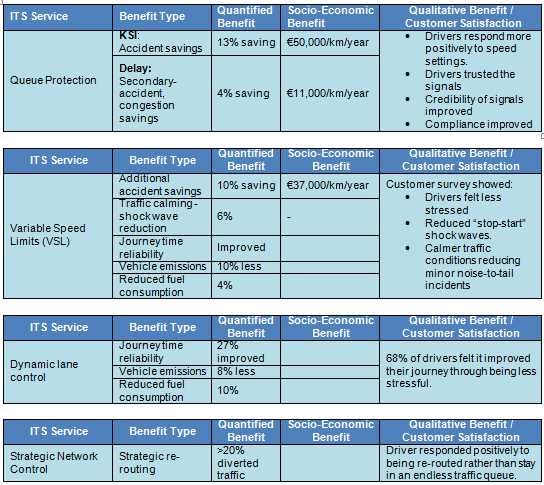
Road Network Operations
& Intelligent Transport Systems
A guide for practitioners!

Road Network Operations
& Intelligent Transport Systems
A guide for practitioners!
It is clear from media coverage that the changes that ITS interventions are intended to achieve are not necessarily apparent to, or welcomed by, all transport users. This means that agencies planning to introduce potentially controversial ITS technologies need to be well-prepared with convincing, evidence based arguments to communicate their aims. Examples are shown below.
|
ITS Intervention |
Policy Aim |
Public Perception |
|
Urban Road User Charging
(on existing routes using electronic fee collection technology) |
manage traffic demand and reduce congestion, time delays and pollution invest net revenues in better public transport to influence modal shift |
Public objections to being charged to use roads that the public has already paid for from its taxes |
|
|
|
Results: Urban congestion charging often scores badly in public opinion and referenda Public opposition is a deterrent to elected local politicians, who need voter support |
|
Success Story - London Congestion Charging: was politically achievable because it relied on a quickly-installed enforcement method - automatic, on-street numberplate recognition cameras to record vehicles whose owners were not recorded in the back-office database as having paid the charge. it was up and running, with its benefits becoming apparent, within a single four-year term of an elected mayor |
|
Success Story – Stockholm Congestion Charging: was politically achievable because it was implemented after a comprehensive public consultation its net revenues are used to part finance other infrastructure investments it was subject to a referendum held after its introduction |
|
ITS Intervention |
Policy Aim |
Public Perception |
|
Camera Enforcement: Red Light Running Speed Enforcement |
reduce the severity of accidents and save lives |
invasion of an individual’s privacy penalty fines viewed as hidden local government “taxation” red light camera enforcement has come under strong challenge in the US. |
|
ITS Intervention |
Policy Aim |
Public Perception |
|
Adaptive In-vehicle Speed Control technologies |
reduce the severity of accidents and save lives reduce the costs associated with accidents smooth traffic flows |
driver perception of loss of individual control |
The benefits of ITS are varied and not always directly calculable. For example, real time information systems on public transport are often introduced at the same time as bus priority measures which make the service faster and more reliable, and very often with new or refurbished vehicles:
The benefits of ITS can be assessed in three ways:
Preventing or reducing the severity of an incident saves emergency service costs, hospital and medical costs and losses to the economy thorough lost productivity. Often these are combined and quantified for Killed and Serious Injury (KSI) incidents and where possible need to be quantified for the country, location or highway being considered for the application of ITS.
Speeding up traffic in urban area by means of “smart” computer-controlled traffic signals or smoothing traffic on motorways to eliminate stop-start conditions will bring travel-time savings.
ITS can provide cash benefits in a number of ways – for example, by reducing the initial capital investment in road infrastructure, or by offsetting operational costs to achieve revenue savings. These are often termed as “real” money savings as opposed to socio-economic benefits:
Measuring customer satisfaction can be accomplished by asking whether the ITS product or service is delivering sufficient value or user benefit to outweigh the cost or investment in the product. This is often done through surveys.
ITS is expected to address the needs of not only the travellers but also transport operators, providers and managers. In most cases it may not be possible to assign a quantified benefit. Where results have been quantified – as illustrated in the table below – they can be a useful factor in supporting the business case.

There are many examples where the benefits of ITS have been measured. It is useful to consider both the aggregate and disaggregate benefits - that is to consider the impact the ITS investment will have overall, but also consider where the benefits will fall. Some benefits are in specific goal areas, such as safety. Others will be for specific groups of people, such as the rising population of mobile elderly and disabled people.
As part of its outreach, IBEC arranges sessions, seminars and workshops at World, European, Asia/Pacific and Pan-American ITS congresses and fora. IBEC sponsors sessions on this topic at the annual ITS World Congress.
IBEC also runs internal seminars and in-house training for organisations including the World Bank and the World Road Association (PIARC) and offers training materials in English and Spanish.
Membership of IBEC is open, with the aim of bringing together, and meeting the needs of, not only ITS professionals, but also transport planners, researchers, manufacturers and suppliers of ITS systems, decision-makers in public- and private-sector client organisations, as well as the transport-using public. This last is a very important audience, whose needs for ITS information are not always well catered for.
Members have access to a website library and information services. (See IBEC)